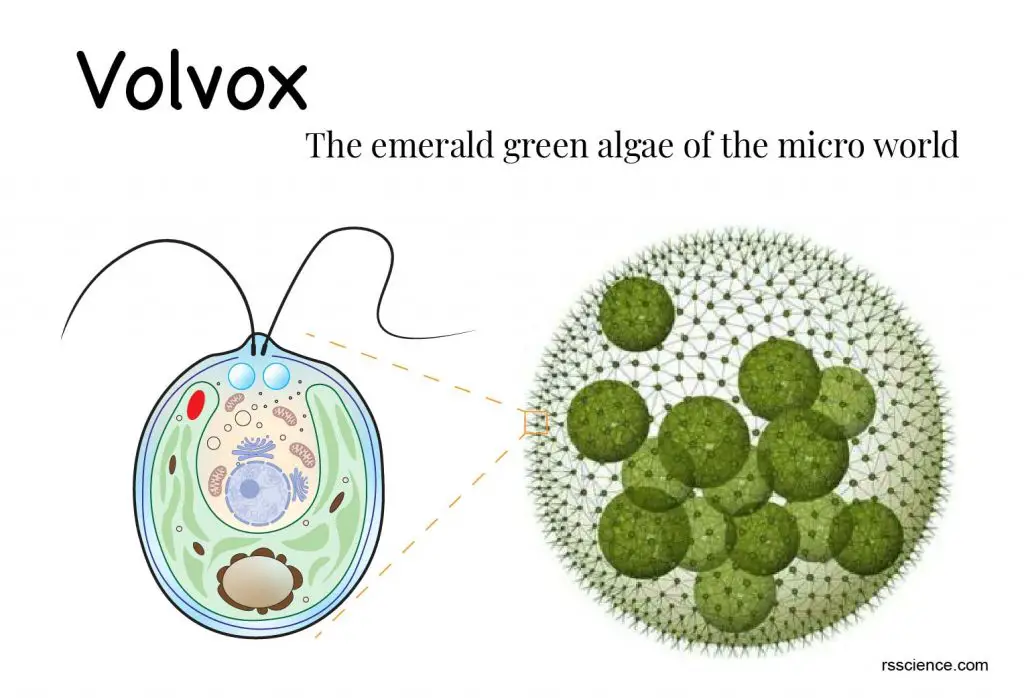This article covers
What is a Volvox? A quick overview
Volvox is a genus of green algae. Volvoxes are free-floating single-cellular algae but typically stay together as spherical colonies (or balls) of 500-50,000 cells. They can live in a variety of freshwater habitats, including ponds, pools, and ditches. Under a microscope, volvoxes look like green marbles slowly rotating, making them one of the most adorable microscopic organisms.
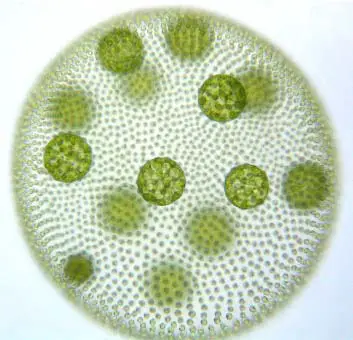
[In this image] A mature Volvox carteri colony with many daughter colonies inside under a microscope.
Photo source: http://www2.unb.ca/vip/photos.htm
[Video] Volvox aureus under the microscope.
Classification of Volvox
Volvox is a polyphyletic genus of Chlorophyte green algae in the family Volvocaceae. Volvox is classified in the class Chlorophyceae due to the presence of chlorophyll.
Scientific classification
Domain: Eukaryota
Kingdom: Plantae
Phylum: Chlorophyta
Class: Chlorophyceae
Order: Chlamydomonadales
Family: Volvocaceae
Genus: Volvox
(Reference: wiki)
There are 20 species of freshwater Volvox. Common species are Volvox aureus, Volvox globator, Volvox carteri, and Volvox barberi, etc.
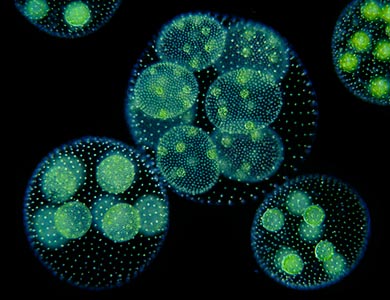
[In this image] Volvox carteri under ultraviolet light.
Photo source: Microbe wiki
The cell structure of Volvox
A typical volvox colony consists of a hollow sphere of cells. Each ball, or coenobium, is formed by a single layer of superficial cells joined together. Each cell is surrounded by a thick mucilaginous wall, forming a gelatinous layer that holds the hollow ball together. In some volvox species, these mucilaginous walls may fill up the internal space of the sphere.
These superficial cells are also called vegetative cells or somatic cells. Each vegetative cell sitting on the surface of the sphere bears two flagella. These flagella face the side of the surrounding water and beat to propel the whole colony through the water. This is why a volvox moves like a rolling ball.
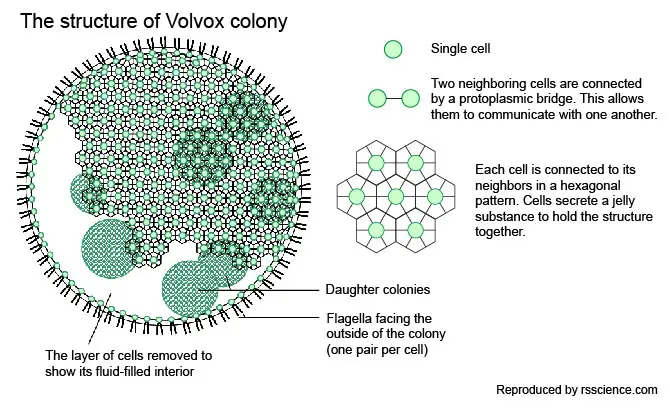
[In this figure] Volvox is a hollow sphere of 500 – 50,000 cells, called a colony or coenobium. The hollow ball consists of a layer of cells. Each cell has a pair of whip-like flagella. The flagella beat in synchrony, allowing the colony of cells to swim.
Image modified from cronodon.
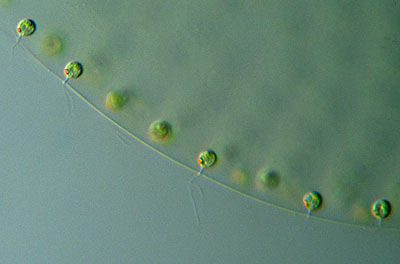
[In this image] A close view of vegetative cells on the surface of a Volvox colony. Two flagella and one red eyespot are visible.
Photo source: microscopy-uk.org.uk
Other than flagellated somatic cells, a mature Volvox colony also contains reproductive germ cells. The number of germ cells is less than somatic cells and locate in the center of the sphere.
Inside the vegetative cell, there is a nucleus, a cup-shaped chloroplast, several contractile vacuoles (water-regulating), and other cell organelles. Each vegetative cell has a red eyespot (stigma) which can sense light. Volvox, like other green algae, is photosynthetic and it swims toward the light (called phototaxis) to keep itself illuminated. If the light is too strong, volvoxes also move away from very bright lights that may damage their chloroplasts. The Volvox ball has a preferred front-end and cells in the front of the sphere have larger eyespots than the rest. These eyespots guide the movement of the volvox colony. The reproductive cells are grouped at the rest side.
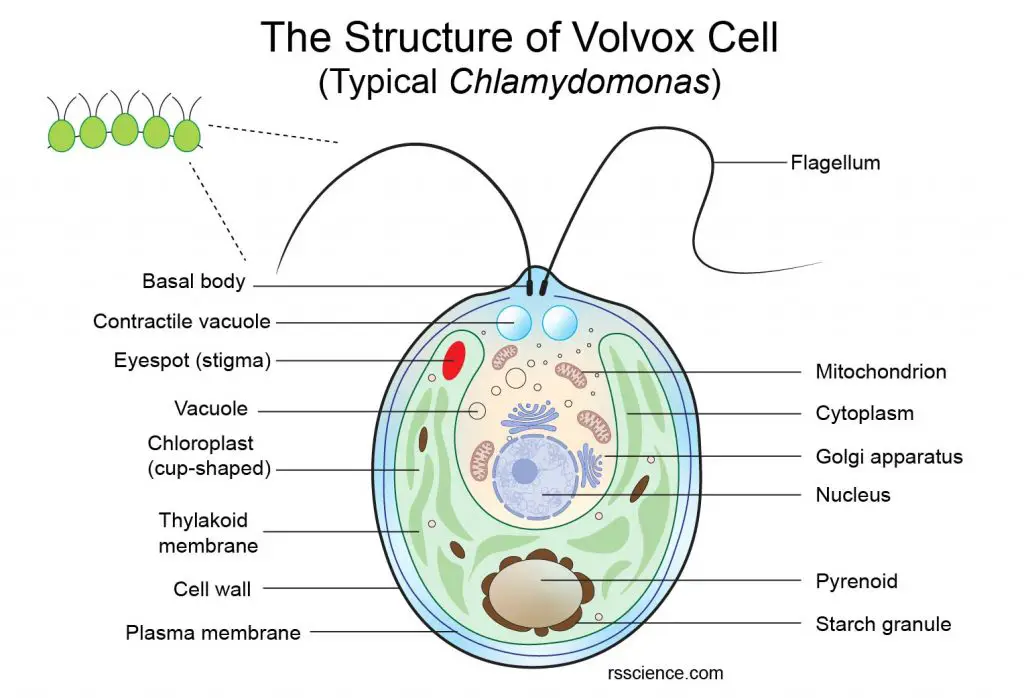
[In this image] A volvox somatic cell is pear-shaped with distinct anterior and posterior poles.
The anterior pole possesses a photosensitive eyespot and two flagella that make it possible for the colony to move towards the light. The base of the flagella bears single cup-shaped chloroplasts. Volvox cell is enclosed by a cell wall and plasma membrane. The central cytoplasm possesses a central nucleus, 2-3 contractile vacuoles, several mitochondria, endoplasmic reticulum, Golgi apparatus (sometimes called dictyosomes in plant cells), ribosomes, etc. Contractile vacuoles act as excretory organs to regulate the water level of the cell. Pyrenoid is a protein body in the chloroplasts of algae that produce and store starch. Each cell measured about 15-25 µm in length.
To coordinate the movement of flagella between individual volvox cells to beat in unison, all the vegetative cells on the surface are connected to their nearest neighbors by protoplasmic bridges. These bridges make all the cells’ cytoplasm continuous, which allows waves of electric signals to travel throughout the volvox colony, triggering flagella motion in a coordinated and controlled manner. In fact, the cell junction functions in the same way between our heart muscle cells to make our heart beat as a whole!
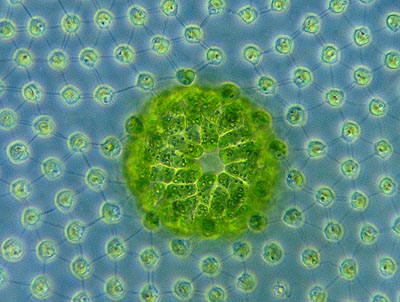
[In this image] The individual Volvox cells are connected by thin strands of cytoplasm, called protoplasmic bridges. The cell cluster in the center is a group of reproductive germ cells.
Photo source: microscopy-uk.org.uk
How does Volvox live?
All Volvox species are able to make their own nutrients through photosynthesis. Volvoxes are green because their cells contain chloroplasts which hold the green pigments, called chlorophyll. The chlorophyll molecules absorb the sunlight and convert it into biological energy. At the same time, photosynthesis also consumes carbon dioxide (CO2) and produces oxygen (O2). Because of the plant-like activities, Volvoxes and all other green algae are autotrophic organisms.
Volvoxes are an important part of the aquatic ecosystem. They are part of the food chain which makes them an important component of the food items for many aquatic organisms such as fish. However, the overgrowth of Volvox aureus could result in a harmful algal bloom. An algal bloom is more frequent in warm waters having a high nitrogen content.
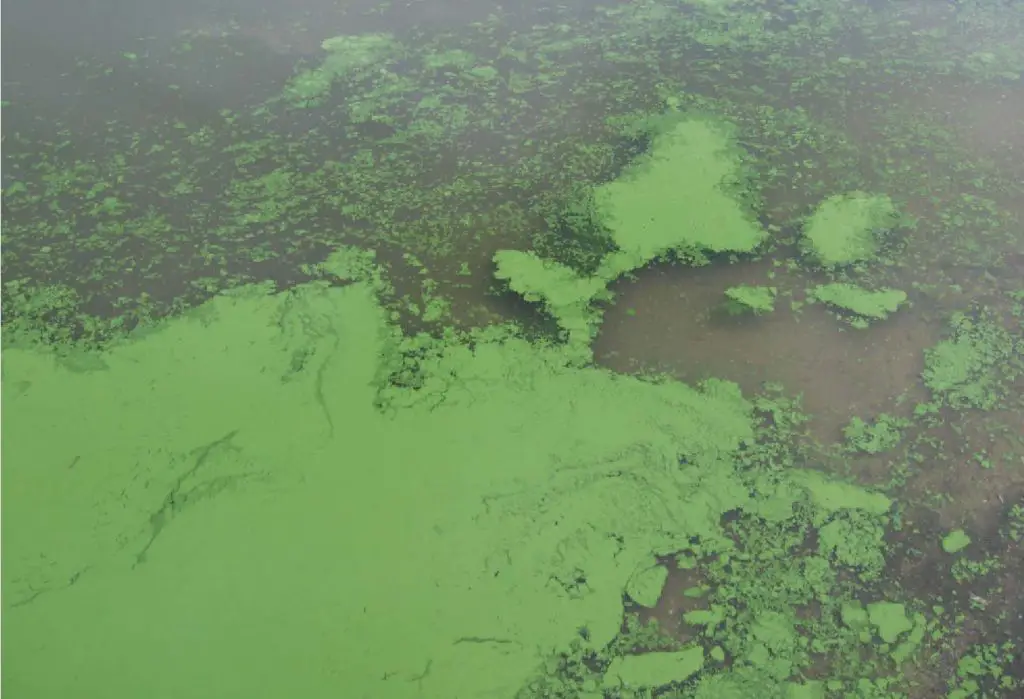
[In this image] Algal bloom in Lake Binder, IA.
Photo credit:: Flickr
How big a Volvox can grow?
A volvox ball or colony is usually a cluster of 500-50,000 cells. These colonies have an ovoid or spherical hollow shape which ranges from 100-6000 µm. A large volvox colony could be as big as a pinhead size.
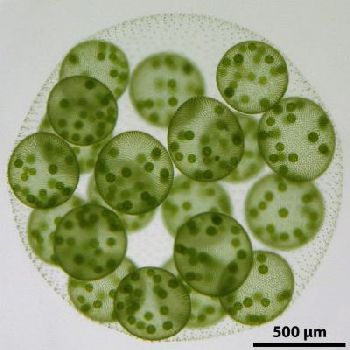
[In this image] A mature Volvox colony is almost 2 mm in diameter (you can read it from the scale bar of the picture). The daughter colonies inside the parental one are ready to release.
How does Volvox reproduce?
Volvox can reproduce asexually or sexually. The choice between asexual and sexual reproduction depends on the conditions where they live. Asexual reproduction takes place during summer under favorable conditions, which allow a rapid expansion of the volvox population. The color of the pond may turn greenish due to the rapid growth of volvoxes. On the contrary, sexual reproduction occurs at the end of the growing season.
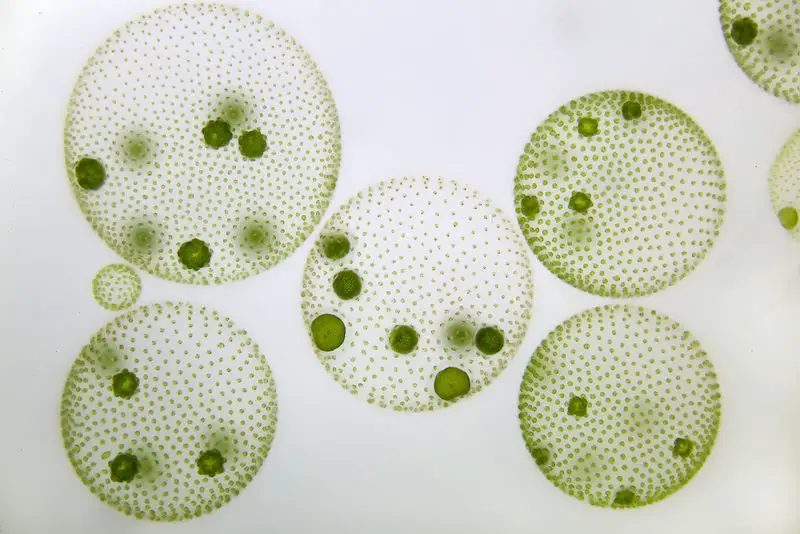
[In this image] Volvoxes grow rapidly during warm seasons.
You may find Volvox colonies of different sizes which represent different stages of the life cycle.
Photo source: wiki
Asexual reproduction of Volvox
Volvox can reproduce asexually by forming new daughter colonies inside the parental colony. These daughter colonies emerge from enlarged cells on the surface of the parent colony, called gonidia (singular: gonidium), at the posterior end of the colony.
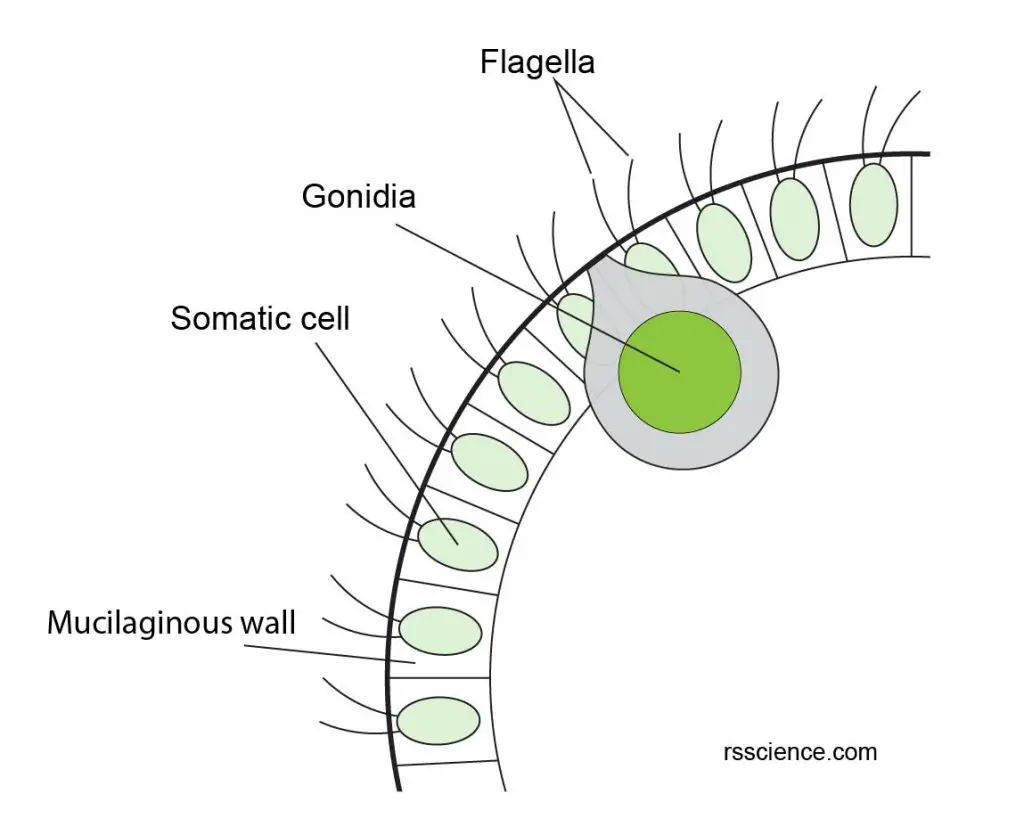
[In this image] The formation of gonidia at the inner side of Volvox.
Gonidia are asexual reproductive cells. They drop their flagella; become rounded in shape; contain dense cytoplasm and lie within a jelly sac that projects towards the inside of the colony. Each gonidium cell divides repeatedly and produces more and more daughter cells. These cells group up and form a cup-shaped plate of cells. Cell division continues and finally, they form a small spherical daughter colony, which is suspended from the parental inside surface.
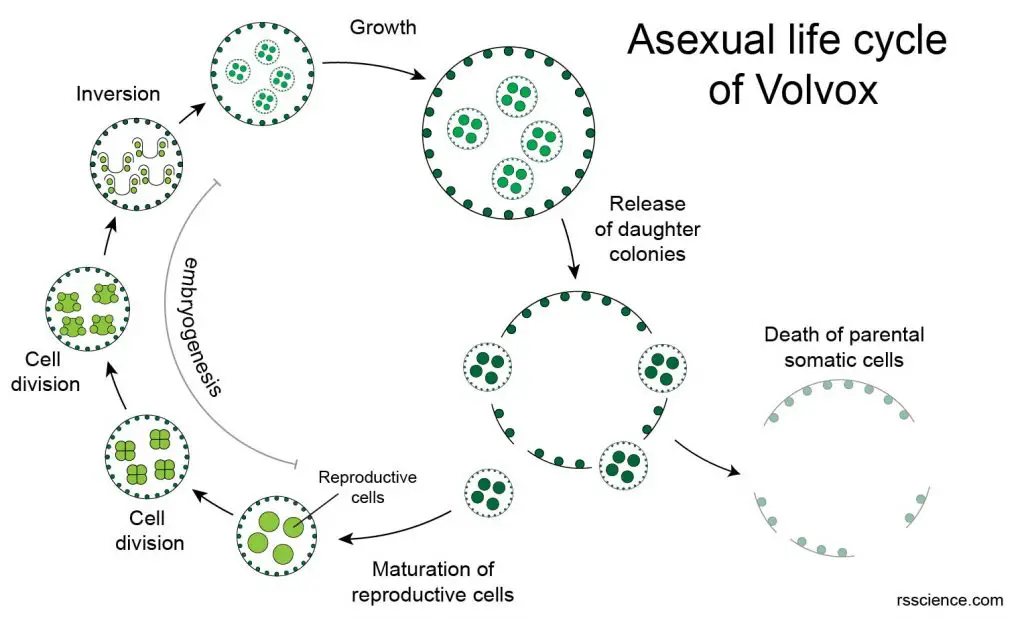
[In this image] The asexual life cycle of Volvox.
The daughter colonies are originally formed inside-out, with their flagella pointing inwards. So, they need to undergo a process of inversion. After inversion, daughter colonies keep growing, which are like many miniature versions of the parent.
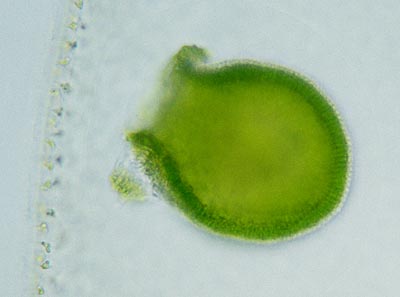
[In this image] A daughter colony is turning itself inside out so the flagella will be orientated towards the outside of the cell.
Photo source: microscopy-uk.org.uk
When the parental colony ruptures and dies, these daughter colonies escape. They keep growing by cell division. One parental colony may release 5-20 daughters. Daughter colonies may contain small granddaughter colonies upon hatching.
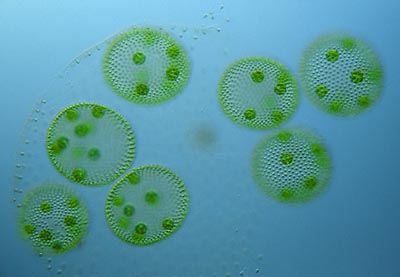
[In this image] Birth of daughter colonies after the parental colony disintegrates. You can see these “granddaughter” colonies are already developing!
Photo source: microscopy-uk.org.uk
Sexual reproduction of Volvox
Some Volvox species are monoecious (only one sex) whilst others are dioecious (with two separate sexes). In dioecious forms, female colonies produce specialized egg cells and male colonies produce packets of spermatozoids, both at the posterior of the colonies. Egg cells lack flagella and remain attached to neighboring cells by the protoplasmic bridges. Sperm cells lack cell walls but have two flagella. Mature sperm cells detach from the parent colony and swim towards egg cells. When a sperm cell fertilizes an egg cell, a thick-walled hypnozygote is formed.
Hypnozygote can stay at the dormant or resting stage for a period of time. If a pond dries or freezes, then the dormant stages can survive until better conditions for growth return. This is why the sexual reproduction of Volvox usually starts at the end of summer.
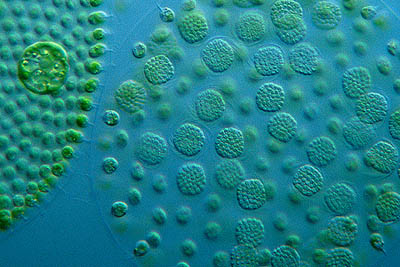
[In this image] Packages of sperm cells are developing in a male Volvox colony.
Photo source: microscopy-uk.org.uk
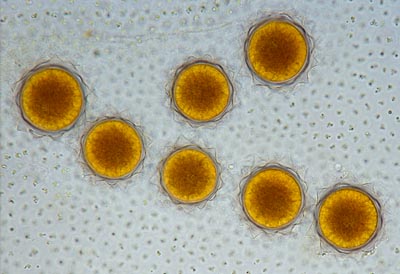
[In this image] Fertilized egg cells develop into hypnozygotes with a hard protective layer. Hypnozygotes are able to withstand harsh conditions and will survive in the winter.
Photo source: microscopy-uk.org.uk
Who discovered Volvox?
Dutch microscopist, Antonie van Leeuwenhoek, first reported the Volvox colonies in 1700. Leeuwenhoek also discovered many other microscopic organisms, such as rotifers and paramecia, by using his simple microscopes.
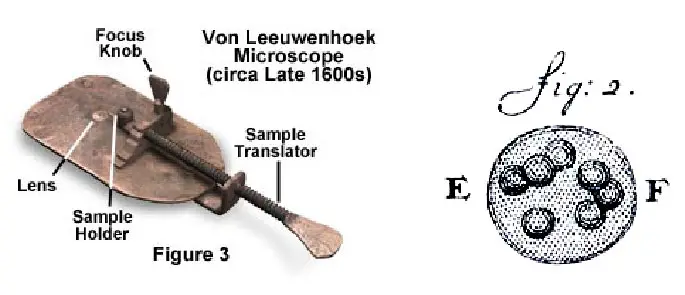
[In this figure] Left: The simple microscope used by Antony Van Leeuwenhoek to discover the microscopic organisms. Right: Illustration of Volvox in Leeuwenhoek’s letter dated January 2, 1700.
Source: minst.org
The evolution of Volvox
Volvoxes evolved from single-cellular Chlamydomonas ancestors approximately 200 million years ago, during the Triassic period. Scientists were fascinated with the evolution of Volvox colonies. They believed the secret of how multicellular organisms came from is there. In fact, they did find the transition from unicellular algae to multicellular Volvox colonies within the family of Chlamydomonas.

[In this image] By studying the family tree of Chlamydomonas, scientists can identify the evolution from unicellular algae to multicellular colonies of Volvoxes.
Photo source: wiki
Volvox is an important model organism
A model organism is a species that has been widely studied in science. Usually, a model organism is easy to maintain and breed in a laboratory setting and has particular experimental advantages. Escherichia coli (a bacterium), yeast, C. elegans (a roundworm), fruit fly, zebrafish, and mice are all important model organisms.
In fact, Volvox is also a model organism that helps scientists to study embryogenesis, morphogenesis, and cellular differentiation. For example, the change in Volvox cell shape during inversion happens in a process analogous to animal gastrulation (an embryo forming its gut).
Summary
- Volvoxes grow as spherical colonies. Each colony may consist of 500-50,000 cells.
- Volvox prefers to live in nutrient-rich water bodies such as lakes, pools, canals, ditches, etc.
- There are three types of Volvox cells: vegetative cells, asexual reproductive cells, and sexual reproductive cells.
- Vegetative cells are somatic cells that form the shell of Volvox ball. Each vegetative cell has two flagella and is attached to each other with cytoplasmic strands.
- Volvoxes can reproduce both asexually and sexually. The decision depends on the environmental conditions.
- By asexual reproduction, reproductive cells grow into daughter colonies within the parent colony. After maturing, the daughter colony comes out from the parent colony.
- By sexual reproduction, female and male reproductive cells become egg and sperm cells. Fertilized cells form hypnozygotes that can survive during the winter or dry season.

[In this image] A interesting picture of both Volvox and Gloeotrichia colonies in the same field. Gloeotrichia is a large colonial genus of Cyanobacteria. Gloeotrichia grows in a filamentous body up to ~ 2 mm in size.
Photo source: wiki
References
“The Natural History of Model Organisms: From molecular manipulation of domesticated Chlamydomonas reinhardtii to survival in nature”
“Volvox, one of the 7 Wonders of the Micro World” by Wim van Egmond

